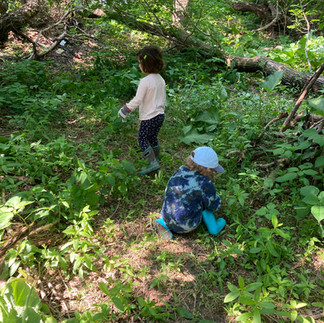Our Neighbour Nettle
- Katie Daman

- Jun 17
- 2 min read
In the Forest where we play, there are two types of Nettle growing around us: Stinging Nettle (Urtica dioica) and Wood Nettle (Laportea canadensis). Stinging Nettle is more likely to show up on the edges of the forest, or along paths, while the Wood Nettle is commonly found in deeper, shadier spots in the forest. Both could be known as our “prickly neighbour”.

Nettle is on everyone’s mind as Esther and I invite the children to be curious about the plants we see, touch, and care for. We will often talk about which plants are abundant enough to use for our mud kitchen soups, salads, and cookies. Nettle is abundant – but it also stings, so the children are rightly nervous about using it. A blog post I came across recently suggests that Nettle can act as awareness medicine. They say Nettle “teaches us how to pay much closer attention to our surroundings, and reminds us that there are consequences for failing to do so.” (The Druids Garden)

Stinging Nettle is a plant that I have grown close to over the last few years, using it in teas and tinctures for its medicinal properties (it's said to be an antihistamine, anti-inflammatory, and more). Inspired by Esther’s work with fibre and teachings about wool this winter, I also attended a workshop at the Riverview Community Centre to learn more about Nettle fibres. Given Nettle’s many gifts, I felt motivated to encourage the children to consider a relationship with Nettle beyond its sting.
I began the process by removing Wood Nettle from their play spaces (respect for the children) and hanging it to dry for future use (respect for the plant). Then, on a day where we were moved inside because of the wildfire smoke, we made Nettle tea with honey and I shared a lesson about turning Nettle into fibers for rope, sails, and cloth. Since we are familiar with turning wool into yarn through winter activities like carding, spinning and making “twisties” (plied yarn), we used the familiar book Pelle’s New Suit to show Nettle’s similar pathway to cloth.
As the week went on, we noticed that some of the children were growing in confidence to walk through new parts of the forest while expertly stepping around the “Wood Nettle” or the “Stinging Nettle”. If someone was stung, we were reminded of one of the lessons we learned to soothe our sting with juices from the Nettle plant. Children were eager to share this medicine with others!
The children who were especially interested in the whole cycle of harvesting, drying, and processing also asked for gloves and scissors to harvest their own Nettles. Working together, we continued to find spots within our play areas where we could sustainably harvest, followed by places to hang and dry the Nettle.
We’re thankful to deepen our relationship with a neighbour and hope the children will continue to love and learn from Nettle for many years to come. Cheers, Nettle! Thank you, Forest!

























Comments